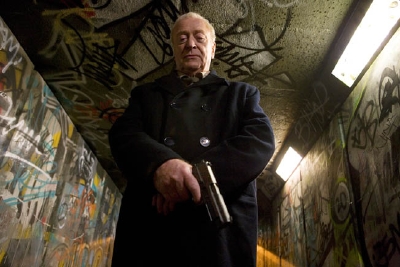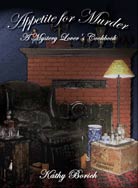Harry Brown: Bubble and Squeak Recipe
Year Released: 2010
Directed by: Daniel Barber
Starring: Michael Caine, Emily Mortimer
(R, 102 min.)

"All that is necessary for the triumph of evil is for good men do nothing." Edmund Burke
What does it say about a society that depends on a wheezy 80-year-old to clean up its streets? Michael Caine takes us where we’d rather not go in his portrayal of a reluctant vigilante trying to catch the bad guys as well as his ragged breath.
And in so doing he shows us a world many are determined to deny. Our own local critic demands “Harry Brown – both the man and the movie – ought be kept off the streets.” These forbidden streets are in South London, where yobs – “boy” spelled backwards to indicate the antithesis of what one should be – rule. It is a savage world of casual brutality, where any semblance of conscience, remorse, or compassion has long been trampled underfoot.
Harry Brown lives in the Council Flats – Britain’s bland euphemism for its housing projects – and watches helplessly the chaos around him. The film opens with a shaky camera recording some young thugs getting high and then taking off on their motorbikes. They are probably only tangentially aware of the young mother they mow down with their gunshots, their drug-addled consciousness buffering them from the reality of the deed. Yet, somehow, these giggling villains are even more appalling than cold-blooded murderers.
Harry, a Korean War vet, keeps his head down and goes on. He avoids the tunnel pass under the highway, the hangout of the young hoodlums, as though it is the entry to Dante’s Inferno, instead sloshing through the rain soaked grass on his daily trek to the hospital where he visits his dying wife. His one respite is his daily chess game with his best friend Leonard, who confesses to him that he lives his life in fear of the thugs who seem to get a large portion of their jollies harassing him.
When his wife dies, and then Leonard is killed by these thugs, who christen their act by urinating on him, something in Harry snaps. But it is the vacuum set up by the well meaning but ineffectual police that sets up his situation. Emily Mortimer, the daughter of the greatly beloved creator of Rumpole of the Bailey, plays Detective Frampton, certainly filled with empathy for Brown – she goes herself to tell him the news of his friend’s death – but she is entirely out of her league in questioning the usual suspects.
Or maybe that’s how all the British bobbies are now. The way she stoically takes the sexually charged insults the brazen thugs toss at her during interrogation makes me long for NCIS’s Ziva to step into the room for a few tortuous minutes. Somehow I don’t think an American female detective would be so passive. It is the enabling British police, after all, who stand ready to pass out flip-flops instead of drunk and disorderly citations to tipsy females who exit the pubs in their platform heels. Wouldn’t want the inebriated poor young things to sprain their precious ankles.
Yes, Harry Brown may be a reluctant vigilante, his tired body not quite up to the task, but he is every bit as fearless as he is frail. The drug lair where he goes to purchase an illegal gun is certainly a scene from hell, the two householders he must deal with making subhumans look good. One of them, his body and face so desiccated that he really looks like a genuine heroine addict, is especially frightening.
Not only does Harry face him down, but he takes him out when he refuses to render aid to the resident damsel in distress, in this case a young woman comatose on the couch with a needle in her arm. When the druggie’s gun jams, the ex-British marine resurfaces in Brown, who tells him sternly, “You failed to maintain your weapon, sir,” just before he issues him off to a better world.
Of course, the main attraction of the film is Caine himself, who plumps out what could be a cardboard character into three-dimensions. In his frail body, besieged by age and emphysema, is a deep and righteous fury. He’s seen a lot of violence, but this is different:
Frampton: It's not Northern Ireland Harry.
Harry Brown: No it's not. Those people were fighting for something; for a cause. To them out there, this is just entertainment.
The fact that Michael Caine has lived in the shoes of his character is perhaps why he wears his role like a second skin. Born Maurice Joseph Mickelwhite, he was the son of a charwoman and a fishmarket porter. Caine grew up in the Castle and Elephant district just a few blocks away from where Harry Brown was filmed. And yes, he belonged to a gang, though their drug was alcohol and they fought with their bare fists instead of knives or guns.
His experience in the Korean War also mirrors Harry’s. What nailed the part for him was this recollection from that conflict, when he was only nineteen years old.
At one point, we were ambushed in the paddy fields, just four of us surrounded by Chinese. And my instinct – which has lasted me the rest of my life – was: All right, I’m going to die. And that’s okay. But, as many of you as possible are going to die with me. I’m going to take out the whole f—ing lot.
This gritty film is not to miss, Caine’s British version of Gran Torino with his unique stamp on it. And don’t miss the equally riveting song from the score, Plan B’s “Chase and Status” done by the talented rap artist who makes us loathe him in the film.
—Kathy Borich
Film-Loving Foodie
The dark and cozy pub where Harry sips his pint while he plays chess with his friend Leonard is a sort of home for them, in spite of the young hoodlums who dart in and out of the place like so many cockroaches.
Let’s cook them up some typical pub grub, much cheaper and better, in my opinion, than anything you will find in London’s restaurants. Here is one with a history as interesting as the dish. The recipe offers two explanations for the peculiar name.
Our Bubble and Squeak is the perfect ending for any leftover cabbage and potatoes. And don’t forget to wash it down with a great British pint. I’d suggest Stella Artois, very popular in the UK, although I think it’s brewed in Belgium.
Bubble and Squeak
"The substance and sustenance of this onomatopoetically dubbed dish are leftover vegetables which first boil (bubble) and the fry (squeak)."
Mimi Sheraton
Bubble and Squeak
(A pub owner’s explanation for the dish’s name lies in its effect on the digestive tract)
- 4 cups well-drained, cooked, chopped cabbage
- 1/3 cup butter
- 1 small onion, minced
- 2 cps diced boiled potatoes
- Salt and freshly ground pepper
Put the cabbage in a colander and press out as much water as possible. Melt butter in a 10-inch skillet and brown onion. Add the cabbage and potatoes and toss until they start browning; season with salt and freshly ground pepper. Smooth mixture and cook until crusty and brown on the bottom. Invert on a heated platter and cut like a pie. Leftover diced or ground meat may be browned along with cabbage and potatoes.
Recipe Source: Appetite for Murder: A Mystery Lover’s Cookbook



 Rainy Day Rentals
Rainy Day Rentals